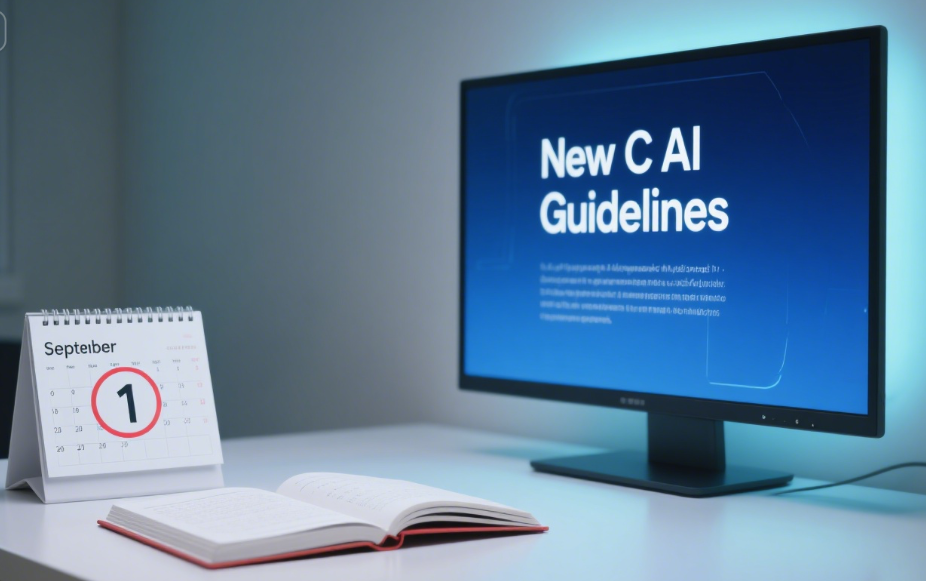
Imagine scrolling through your feed and seeing a viral video of a celebrity saying something outrageous. You're ready to share it—but then you notice a tiny watermark in the corner labeling it as AI-generated. This simple identifier could prevent the next misinformation wildfire. Starting September 1, 2025, this scenario becomes reality across China under the groundbreaking New C AI Guidelines officially titled Artificial Intelligence Generated Content Identification Method. Jointly released by four powerful regulators—Cyberspace Administration, MIIT, Ministry of Public Security, and National Radio and Television Administration—these rules mandate visible and invisible markers for all AI-generated content, transforming how synthetic media is created and consumed. For AI developers, businesses, and everyday users, compliance isn't optional; it's the new frontier of digital trust.
Core Purpose: The New C AI Guidelines establish a dual-tagging system (visible watermarks and invisible metadata) to combat AI-generated misinformation while supporting ethical innovation. All AI service providers must comply by September 1, 2025, or face regulatory penalties.
Decoding the Dual-Tagging System: Visible & Invisible Identifiers
The cornerstone of the New C AI Guidelines is a two-layered identification framework designed for both human and machine verification:
1. Explicit Identification (Human-Visible)
These are impossible-to-miss markers added directly to content or interface elements:
Text: Header/footer labels like "AI-Generated" or ?? symbols at start/end
Audio: Voice announcements ("This is synthetic audio") or distinct sound tones
Images: Semi-transparent watermarks in corners (e.g., "Synthetic Image")
Video: Persistent on-screen badges during playback + intro/outro warnings
Platforms must ensure these tags survive downloading or copying, closing loopholes for misuse .
2. Implicit Identification (Machine-Readable)
Hidden in file metadata using the newly standardized Service Provider Encoding Rules, these include:
Content generation attributes (e.g., model type, version)
Service provider ID or cryptographic signature
Unique content serial numbers for traceability
Encryption or digital watermarking is encouraged to prevent tampering. Major platforms like Tencent and Baidu are already testing blockchain-based solutions .
Discover How Leading AI Platforms Are Adapting
Platform Obligations: Beyond Basic Tagging
The New C AI Guidelines impose proactive verification duties on content-sharing platforms:
| Situation | Required Action | User Notification |
|---|---|---|
| Detected hidden tag | Add visible warning | "This is AI-Generated Content" |
| User self-declares AI content | Add visible warning | "Possible AI-Generated Content" |
| Suspected untagged AI content | Add visible warning + review | "Suspected AI-Generated Content" |
App stores like Huawei AppGallery must now verify AI labeling compliance during developer onboarding. Violations could trigger fines up to ¥500,000 under existing cybersecurity laws .
Why the September Deadline Matters for Innovation
Contrary to concerns about stifling innovation, the New C AI Guidelines create guardrails that actually enable responsible advancement:
Trust Catalyst: A 2024 Tsinghua University study showed watermarking increased user trust in AI tools by 62%
Legal Shield: Platforms using compliant tagging gain liability protection against deepfake-related lawsuits
New Tech Markets: Demand for tamper-proof tagging tools is projected to create a ¥8B industry by 2026
As one Alibaba AI engineer noted: "Forcing us to develop unremovable watermarks pushed breakthroughs in lightweight cryptography we wouldn't have pursued otherwise" .
Your Blueprint for Ethical AI Implementation
Implementation Challenges: The Road Ahead
Despite clear benefits, technical and operational hurdles remain:
? Cross-Platform Consistency
Can a TikTok watermark be read by WeChat's verification tools? Standardization work continues through NISSTC's upcoming File Format Metadata Specifications .
? Performance Tradeoffs
Real-time tagging in live AI video generation requires optimizations to avoid lag. Early tests show 5–15% latency increases.
? Global Alignment
While the EU's AI Act and U.S. NO FAKES Act propose similar tagging, interoperability frameworks are still nascent .
FAQs: Your Top Compliance Questions Answered
Do personal/non-commercial AI projects need tagging?
The New C AI Guidelines primarily target commercial service providers (e.g., ChatGPT-like tools). However, if you distribute synthetic content via public platforms like Weibo, those platforms must tag it per Section 6 rules .
Can users request untagged content?
Yes, but providers must log your identity for ≥6 months and make you accept legal liability in user agreements (Guidelines Article 9).
What are penalties for removing tags?
Deliberate tag removal/distortion violates Article 10 and may incur fines under Cybersecurity Law (up to ¥500,000) or even criminal charges if used for fraud .
Key Compliance Deadlines
| Date | Milestone | Impact |
|---|---|---|
| Mar 14, 2025 | Service Provider Encoding Rules released | Platforms start metadata testing |
| Sep 1, 2025 | Guidelines & National Standard take effect | Full compliance mandatory |
| Q4 2025–2026 | File-format-specific specs released | Refinements for video/audio/text |
Conclusion: The New Era of Accountable AI
The New C AI Guidelines represent more than bureaucratic compliance—they're a foundation for sustainable innovation. By making synthetic media traceable, we prevent a "Wild West" of generative AI that erodes societal trust. For developers, this means re-engineering workflows to embed watermarks and metadata. For users, it brings critical transparency. And for regulators, it offers a template other nations may follow. As we approach the September 1 deadline, one truth emerges: In the age of synthetic reality, accountability isn't anti-innovation—it's its essential partner.


